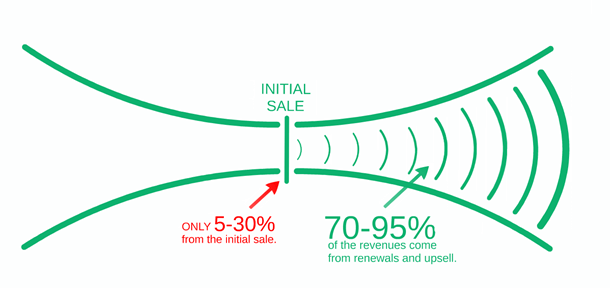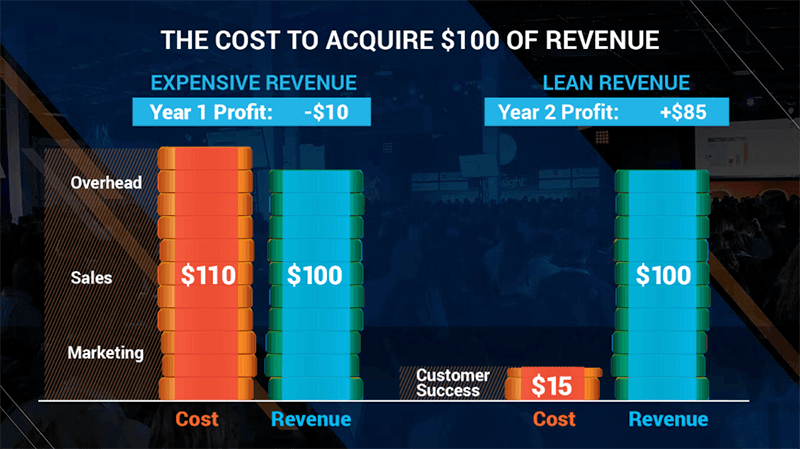Customer success gurus may tell you that in order for your business to succeed you have to have a certain mindset, drive, innovative products, engaging marketing, enthusiasm and a slew of ‘isms’.
Those things help, but the real success of any business is directly related to the success of your customer. If you’re helping solve problems, and the customers find success with your solutions, then they’ll continue using your product.
The biggest barrier to customer success is CEOs not making it an important part of the culture.Nick Mehta
Continued business, and gaining new customers from word of mouth, is what customer success is all about. Achieving that takes more than a basic strategy. It requires a carefully planned process, process automation, the right people, the vision, and good data.
So, What Is Customer Success?
The definition of customer success is simple – success occurs when your customers achieve the desired outcome through interactions with your company, either directly or through your product/service.
That can be broken down into two key elements in order to achieve success. First, the desired outcome.
Customers have a certain expectation, or result, they want the use of your product or service.
The other element is the interaction with your company. Since every company is different it’s not appropriate to just refer to interactions with your product. The focus should be on a broader scale, touching on interactions with the brand or company overall. This is because success isn’t just about the use of the product. It comes from experiences at each stage of the buying cycle across different teams.
Customer Success vs. Customer Service
While both customer success and customer service focus on customer-centric operations, they’re different approaches. Customer success is about establishing proactive programs, processes, operations designed to set your customers up for the best experience.
Customer service is a more reactive approach, tackling issues that arise after the fact.
Both are equally important since customer service programs and processes can lead to the discovery of opportunities to proactively take care of your customers.
Why Customer Success is Important
Being proactive lays the groundwork for long-term customer success and has a number of benefits, including:
Boosting Customer Renewals
Customers have become put off my long-term contracts. They want the freedom to leave, even if they have no intention of it. The days of locking people into lifetime contracts are over. That might scare you, but customers appreciate the trust.
With a focus on success, you’ll see improved renewals.
Reducing Customer Churn

A lot of companies rely heavily on their marketing and customer acquisition strategies. While customer acquisition is important, it cannot be your sole focus. Creating a customer success strategy ensures that fewer customers are lost, dramatically reducing customer churn. The more you increase the customer lifecycle, the greater the lifetime customer value.
You’ll also see reduced acquisition costs as more long-time customers refer others to your brand.
Customer Success Drives the Revenue Train
At a 2015 Gainsight Pulse conference, Jason Lemkin, the managing director of Storm Ventures said: “Customer Success is where 90% of the revenue is.” Essentially, the majority of your revenue is going to come from your relationship with a customer post-sale. One that is built through continued engagement and nurturing.

In the above, you can see a comparison of the costs of acquiring a new customer vs retaining the customers you already have. As you can see, the cost to retain a customer is a fraction of those expenses involved in customer acquisition.
Managing Customer Success
There are terrific benefits to customer success, but it’s not something that happens organically, or accidentally. Finding that success takes careful planning and management – essentially, the proactive orchestration of the customer’s journey toward their desired outcome
When you use words like “orchestration”, it’s clear there’s a fairly elaborate and defined process behind it. Here are 8 elements to consider as part of customer success management:
- Segmentation
- Orchestration
- Intervention
- Measurement
- Expansion (and Renewal)
- Communication
- Instrumentation
- Operationalization
SixteenVentures goes into this full list in-depth, diving into each in this post from Lincoln Murphy
Who is Responsible for Customer Success?
You may have heard the old adage that everyone is involved in sales. The same concept really applies to customer success, because it doesn’t stem from a single customer touch point.
Granted, some larger brands have dedicated teams for customer success and that makes it easy to point the finger at a specific department and say “that’s their job.”
Most brands don’t have that. Instead, customer success becomes a vision and purpose across the whole of the company. It’s in the job description for every employee from the top down. When communicated effectively, everyone in the organization understands their role in helping customers achieve the desired outcome.
Every point at which a customer interacts with your brand (and staff) becomes a touch point and an opportunity for customer success.
What Customer Success is Not
I’ve seen some common misconceptions about what customer success is, and you have to be careful about your understanding of it before attempting to implement it and build a strategy for your own organization.
Too narrow a focus and you’ll be missing opportunities, spending vast resources to achieve minimal results – if any. Customer success management can be tremendously powerful in helping you grow your business, but only if you understand what it isn’t.
Customer success is not:
- Just a department you delegate tasks to, with an after-hours voicemail
- Simply limited to whoever is in charge of managing accounts
- Isn’t limited to (and shouldn’t be limited to) your customer service team
- About limiting or mitigating churn
- All about saving customers
- A method for babysitting customers to keep them from running away
- Simply a way to track product usage
- Your NPS and has very little to do with your net promoter score. NPS is just one factor in overall success
- Happiness, customer delight, or general satisfaction with how your company operates.
Common Organizational Models of Customer Success
Understanding who owns customer success at your company is a difficult part of the building process. While it’s true that many people are involved, there ultimately needs to be someone accountable for ensuring the programs work, and fixing things when something goes wrong.
There’s no single way to structure your organization for customer success, but there are some common organizational models that you can follow.
FireFighter – Typically seen in smaller organizations or early-stage startups. In this model, customer success is responsible for supporting customers as well as relationship building and other post-sales activities that include renewals. Under this model, your success management team becomes a one-stop-shop for customers. The downside is that this isn’t the most scalable model and you’re under a great deal of pressure to get the right people in place on your team.
Sales Oriented – This model is most often seen in companies that don’t have a very complex product but a competitive focus on sales and renewals. A good example would be an e-liquid manufacturer driven to keep wholesale orders inbound with retail customers. This puts the focus on revenue and driving upsells. The downside here is that the focus is less on the customer, and that can have a negative impact on the customer relationship.
Service Oriented – This is the model you’ll see in larger, more mature organizations. With this model, the company has aligned themselves with the needs of the customer while also meeting the needs of the company. The downside to this is it often adds more touch points for the customer (which some could take negatively) and isn’t necessarily geared on driving revenue. There’s still the revenue gain from improving customer success, but alignment to revenue with this model isn’t emphasized.
Integrated – This kind of model is most commonly seen in companies focused on hyper-accelerated growth, often with moderately complex products. It’s common to see a dedicated individual or Chief Customer Officer who owns existing customer success while driving the sales team on the acquisition of new customers.
Partnership – The partnership model is typical for companies with competitive sales and renewals of very complex products. Customer success can remain very customer focused on this model despite longer and more complex relationship building, since renewal sales are often high value.
Conclusion
Customer Success may be a relatively new movement, leading us away from reactive customer service models, but it’s effective and needs to be more widely adopted. Especially since the core concepts of customer success aren’t really new for many companies. Only the perspective and strategies in how the elements work together to help customers reach their goal.
If growth is what your organization is looking for then invest in customer success and create strategic initiatives. Bring your teams together with a singular purpose of making your customers more successful so the entire organization is aligned around the same concept.
Photos by Dominic’s pics

